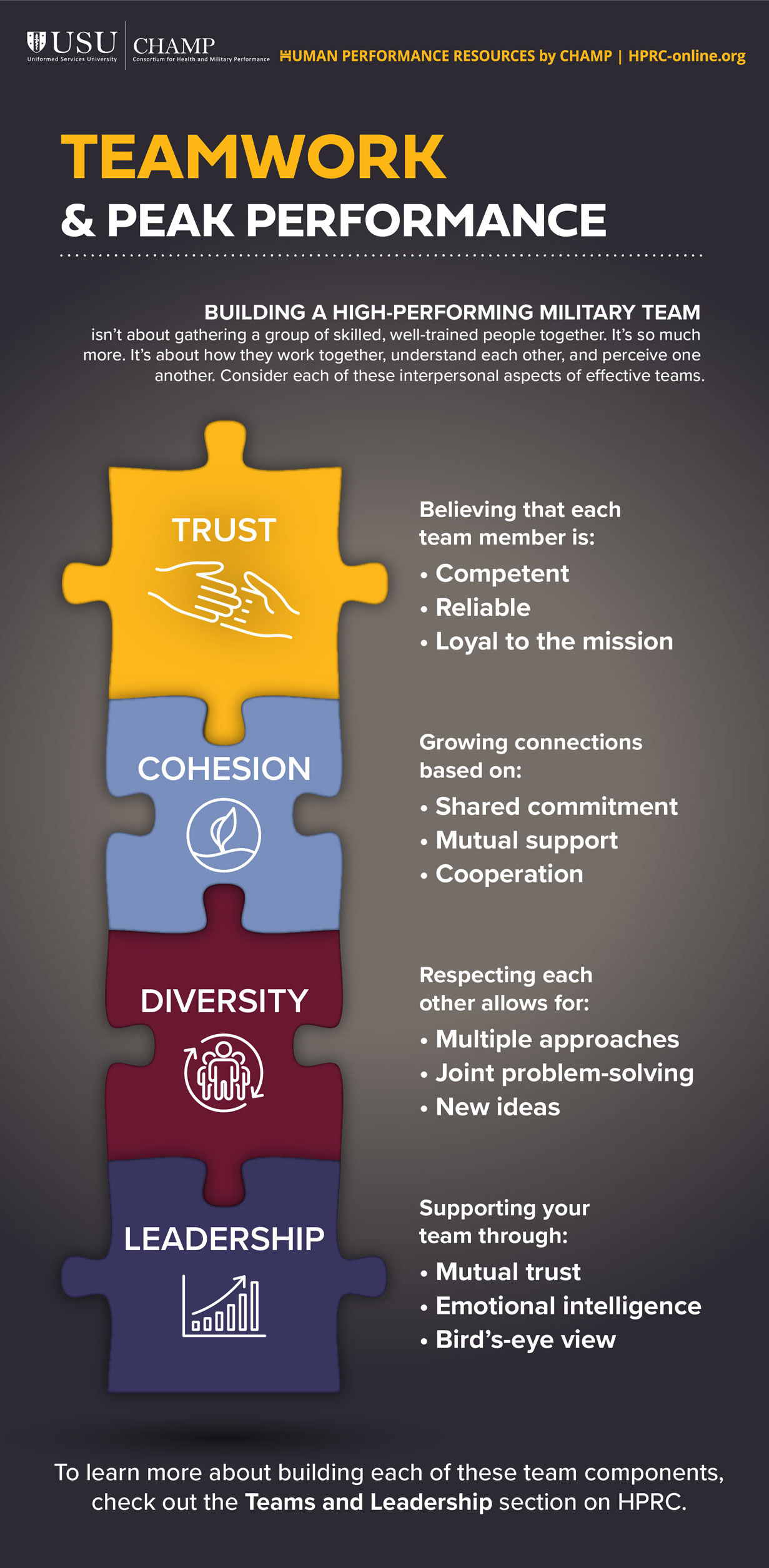High-performing military teams are crucial to mission success. But it takes more than just tactical military training for teamwork to be effective. For teams (and individuals) to complete mission-essential tasks, it takes strong, interpersonal social-fitness skills on top of tactical training. So, what are the person-to-person skills and beliefs that make up high-performing teams?
- It starts with trust—in each other’s dedication to the mission and the team.
- With trust comes team cohesion and your teammates uniting to complete a task and form one-on-one connections, no matter how different their backgrounds.
- Diversity, another key component of optimized teams, is about accepting and recognizing how different skills and experiences can boost creativity and support problem-solving.
- But at the top of it all, high-performing teams have high-performing leadership. The best leaders foster trust, cohesion, and diversity while also using their own interpersonal skill sets to support their teams across the board.

Teamwork & Peak Performance
Building a high-performing team isn’t about gathering a group of skilled, well-trained people together. It’s so much more. It’s about how they work together, understand each other, and perceive one another. Consider each of these interpersonal aspects of effective teams.
Trust is believing that each team member is competent, reliable, and loyal to the mission.
Cohesion is about growing connections based on shared commitment, mutual support, and cooperation.
Diversity means respecting each other’s differences to allow for multiple approaches, joint problem-solving, and new ideas.
Leadership is about supporting your team through mutual trust, emotional intelligence, and a bird’s-eye view.
To learn more about building each of these team components, check out the Teams and Leadership section on HPRC.
Published on: March 3, 2021
References
Ahronson, A., & Cameron, J. E. (2010). The nature and consequences of group cohesion in a military sample. Military Psychology, 19(1), 9–25. doi:10.1080/08995600701323277
Bass, B. M., Avolio, B. J., Jung, D. I., & Berson, Y. (2003). Predicting unit performance by assessing transformational and transactional leadership. Journal of Applied Psychology, 88(2), 207–218. doi:10.1037/0021-9010.88.2.207
Brown, U. J., Knouse, S. B., Stewart, J. B., & Beale, R. L. (2008). The relationship between unit diversity and perceptions of organizational performance in the military. Journal of Applied Statistics, 36(1), 111–120. doi:10.1080/02664760802443905
Driskell, T., Salas, E., & Driskell, J. E. (2018). Teams in extreme environments: Alterations in team development and teamwork. Human Resource Management Review, 28(4), 434–449. doi:10.1016/j.hrmr.2017.01.002
Frigotto, M. L., & Rossi, A. (2011). Diversity and communication in teams: Improving problem-solving or creating confusion? Group Decision and Negotiation, 21(6), 791–820. doi:10.1007/s10726-011-9250-x
Grossman, R., & Feitosa, J. (2018). Team trust over time: Modeling reciprocal and contextual influences in action teams. Human Resource Management Review, 28(4), 395–410. doi:10.1016/j.hrmr.2017.03.006
Kirkpatick, S. A., & Locke, E. A. (1991). Leadership: Do traits matter? Academy of Management Perspectives, 5(2), 48–60. doi:10.5465/ame.1991.4274679
Lambert, J. (2016). Cultural diversity as a mechanism for innovation: Workplace diversity and the absorptive capacity framework. Journal of Organizational Culture, Communications and Conflict, 20(1), 68–76.
McColl-Kennedy, J. R., & Anderson, R. D. (2002). Impact of leadership style and emotions on subordinate performance. The Leadership Quarterly, 13(5), 545–559. doi:10.1016/s1048-9843(02)00143-1
Stanley, D. (2003). What do we know about social cohesion: The research perspective of the federal government's social cohesion research network. Canadian Journal of Sociology / Cahiers canadiens de sociologie, 28(1). doi:10.2307/3341872
Sweeney, P. J., Thompson, V., & Blanton, H. (2009). Trust and influence in combat: An interdependence model. Journal of Applied Social Psychology, 39(1), 235–264. doi:10.1111/j.1559-1816.2008.00437.x
van Knippenberg, D., van Ginkel, W. P., & Homan, A. C. (2013). Diversity mindsets and the performance of diverse teams. Organizational Behavior and Human Decision Processes, 121(2), 183–193. doi:10.1016/j.obhdp.2013.03.003




